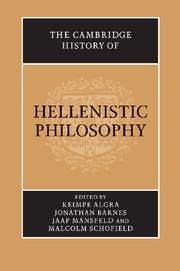Book contents
- Frontmatter
- PART I INTRODUCTION
- PART II LOGIC AND LANGUAGE
- PART III EPISTEMOLOGY
- PART IV PHYSICS AND METAPHYSICS
- 11 Hellenistic physics and metaphysics
- 12 Cosmology
- 13 Theology
- 14 Explanation and causation
- 15 Determinism and indeterminism
- 16 Epicurean psychology
- 17 Stoic psychology
- 18 Philosophy, science and medicine
- PART V ETHICS AND POLITICS
- Synopsis of principal events
- Editions of sources and fragments
- List of abbreviations
- Bibliography
- Index locorum
- General Index
- References
18 - Philosophy, science and medicine
from PART IV - PHYSICS AND METAPHYSICS
Published online by Cambridge University Press: 28 March 2008
- Frontmatter
- PART I INTRODUCTION
- PART II LOGIC AND LANGUAGE
- PART III EPISTEMOLOGY
- PART IV PHYSICS AND METAPHYSICS
- 11 Hellenistic physics and metaphysics
- 12 Cosmology
- 13 Theology
- 14 Explanation and causation
- 15 Determinism and indeterminism
- 16 Epicurean psychology
- 17 Stoic psychology
- 18 Philosophy, science and medicine
- PART V ETHICS AND POLITICS
- Synopsis of principal events
- Editions of sources and fragments
- List of abbreviations
- Bibliography
- Index locorum
- General Index
- References
Summary
Philosophy and mathematics
The relationship between philosophy and mathematics appears to be less close in the Hellenistic age than in previous centuries. The mathematicians proceeded with their work without any explicit adhesion to philosophical doctrines or any reply to the theoretical and epistemological problems raised by the Epicureans and the sceptics when dealing with mathematics. In the fifth century AD the Neo-platonist Proclus saw Euclid as a Platonist, because his Elements concluded with the construction of regular polyhedrons, the basis of the cosmic structure outlined by Plato in the Timaeus (Eucl. 68.20–3; 70.22–71.5). But there is no proof that Euclid meant to direct the whole of his writing towards the creation of a cosmology.
Another level on which Proclus tried to show Euclidean geometry's dependence on philosophy was the formal structure of the Elements. This was based on the distinction between a small number of principles, assumed at the outset without demonstration and listed in the first book as definitions, common notions and postulates, and a body of propositions reached deductively starting from the principles. Proclus highlighted a correspondence between this structure and the theory of science formulated by Aristotle, particularly in the Posterior Analytics, and also between Euclid's principles and those mentioned by Aristotle (Eucl. 76.6–77.2). It is in fact possible to make out some parallelism: for example, Aristotle includes among the principles used by mathematicians Euclid's third common notion, which is that if equals are subtracted from equals, the remainders will be equal (APo. 76a41).
- Type
- Chapter
- Information
- The Cambridge History of Hellenistic Philosophy , pp. 585 - 614Publisher: Cambridge University PressPrint publication year: 1999
References
- 10
- Cited by

